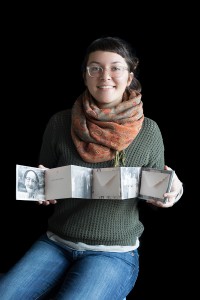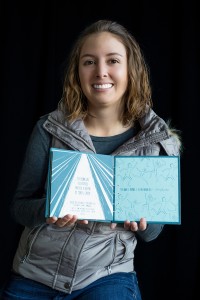Forming ideas for artist books
By Samelia Bankole
In some design classes like Color Theory and Creative Thinking Strategies, students create an artist book for one of their projects.

Creating a handmade book is usually a new experience. Thinking about content, form and the type of binding you’ll use can be overwhelming if it is your first time. The best place to start is developing a strong concept. For printmaking senior, Emma Bilyeu, artist books are a frequent assignment and she has some great advice on what goes into creating a good artist book. She is currently taking papermaking and has created an artist book for the class.
The idea for her two-sided accordion book, “To Other Self, My Eponym,” which was created with handmade paper, started with an old photograph of her great-grandmother. Bilyeu knew she wanted to create something centered on the photo and the papermaking assignment provided the perfect opportunity. From there, she started to build her concept.
“I was named after my great-grandmother and I never met her. So, there is this connection I have with her, but I have only heard stories about her,” she says.
Bilyeu asked her family for a few more photographs of her great-grandmother. She decided to use four black and white photographs in her book. She wrote four letters to complement these family photos. Bilyeu played with the idea of memory, writing these letters to her great-grandmother based on the limited knowledge she had. “I just wrote what came to mind,” she says. The letters were focused on her thoughts about her namesake and included memories from her childhood.
She made several stylistic choices to emphasize the family connection. The letters were typed on her great-grandfather’s Remington Typewriter and she folded the letters in the form of envelopes that viewers can flip open and read. Bilyeu adjusted the layout for the photos in Photoshop and then decided on the placement of the letters in her book.
The handmade quality of the paper, the photos and the hand-typed text created the nostalgic feel that she was looking for.
“I like the extra-layer of interpretation and meaning you can get from the book form,” she says.
Bilyeu’s advice for students making artist books is to always push your original idea. Keep developing your concept through sketches and consider all the possibilities.
For many students, artwork springs from passions and interests. For graduate student and illustration major, Mariel Cartin, her inspiration started with her love for an ancient text.

“I tend to draw a lot of inspiration from the Bible. I have always been intrigued with the struggle between light and darkness, so I began searching for verses that talked about that,” she says.
She created an artist book in a printmaking class this past summer. It was her first time. In her Coptic-bound book, “Children of Light,” Cartin was inspired by a verse from the Book of Ephesians: “For you were once darkness, but now you are light in the Lord. Live as children of light.” The metaphor “children of light” sparked an image in her mind and she began to form a story around the verse.
First, she had the idea of taking several verses from different books in the Bible about light and dark and stringing them together to tell a story. However her professor, Cynthia Lollis suggested she focus on one verse.
Cartin decided to tell this story visually, with no text until the end where she includes the verse. Her story features childlike characters. The main character comes into contact with darkness and searches for the light.
For her process, she sketched her scenes first and then made a book dummy where she drew these scenes from front to back in a narrative sequence.
During the screen-printing stage, she used a limited color palette. “I decided that the light crème color would represent light, dark blue would represent darkness and a mid tone color would be used to separate light and dark,” she says. This made it faster to print her images with her silkscreen. The book turned out to be an amazing work of art that was featured at Open Studio Night in Fall 2014.
The best part of creating a book for Cartin was seeing the process from beginning to end and sharing her work with others. Her advice for students: “Having a clear concept from the beginning is important. Pick a subject that matters to you. Focus on what you’re passionate about.”


























